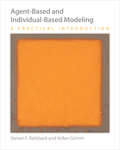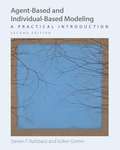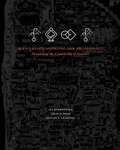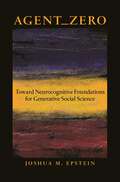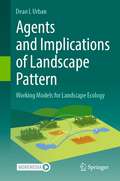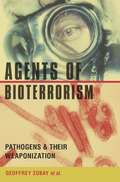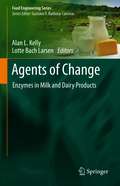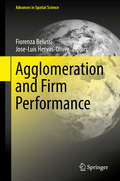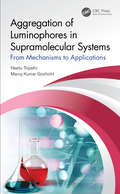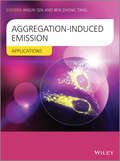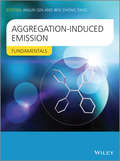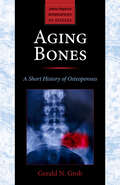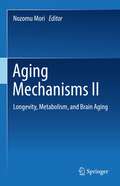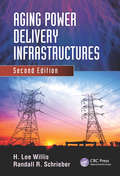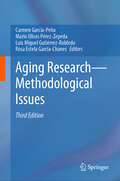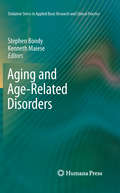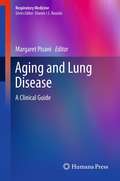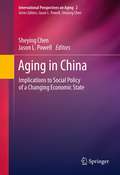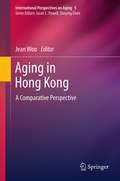- Table View
- List View
Agent-Based and Individual-Based Modeling
by Volker Grimm Steven F. RailsbackAgent-based modeling is a new technique for understanding how the dynamics of biological, social, and other complex systems arise from the characteristics and behaviors of the agents making up these systems. This innovative textbook gives students and scientists the skills to design, implement, and analyze agent-based models. It starts with the fundamentals of modeling and provides an introduction to NetLogo, an easy-to-use, free, and powerful software platform. Nine chapters then each introduce an important modeling concept and show how to implement it using NetLogo. The book goes on to present strategies for finding the right level of model complexity and developing theory for agent behavior, and for analyzing and learning from models. Agent-Based and Individual-Based Modeling features concise and accessible text, numerous examples, and exercises using small but scientific models. The emphasis throughout is on analysis--such as software testing, theory development, robustness analysis, and understanding full models--and on design issues like optimizing model structure and finding good parameter values.The first hands-on introduction to agent-based modeling, from conceptual design to computer implementation to parameterization and analysis Filled with examples and exercises, with updates and supplementary materials at http://www.railsback-grimm-abm-book.com Designed for students and researchers across the biological and social sciences Written by leading practitionersLeading universities that have adopted this book include: Amherst CollegeBrigham Young UniversityCarnegie Mellon UniversityMiami UniversityNorthwestern UniversityOld Dominion UniversityPortland State UniversityRhodes CollegeSusquehanna UniversityUniversity College, DublinUniversity of ArizonaUniversity of South FloridaUniversity of Virginia
Agent-Based and Individual-Based Modeling: A Practical Introduction, Second Edition
by Volker Grimm Steven F. RailsbackThe essential textbook on agent-based modeling—now fully updated and expandedAgent-Based and Individual-Based Modeling has become the standard textbook on the subject for classroom use and self-instruction. Drawing on the latest version of NetLogo and fully updated with new examples, exercises, and an enhanced text for easier comprehension, this is the essential resource for anyone seeking to understand how the dynamics of biological, social, and other complex systems arise from the characteristics of the agents that make up these systems.Steven Railsback and Volker Grimm lead students stepwise through the processes of designing, programming, documenting, and doing scientific research with agent-based models, focusing on the adaptive behaviors that make these models necessary. They cover the fundamentals of modeling and model analysis, introduce key modeling concepts, and demonstrate how to implement them using NetLogo. They also address pattern-oriented modeling, an invaluable strategy for modeling real-world problems and developing theory.This accessible and authoritative book focuses on modeling as a tool for understanding real complex systems. It explains how to pose a specific question, use observations from actual systems to design models, write and test software, and more.A hands-on introduction that guides students from conceptual design to computer implementation to analysisFilled with new examples and exercises and compatible with the latest version of NetLogoIdeal for students and researchers across the natural and social sciencesWritten by two leading practitionersSupported by extensive instructional materials at www.railsback-grimm-abm-book.com
Agent-based Modeling For Archaeology: Simulating The Complexity Of Societies
by Colin Wren Stefani Crabtree Iza RomanowskaTo fully understand not only the past, but also the trajectories, of human societies, we need a more dynamic view of human social systems. Agent-based modeling (ABM), which can create fine-scale models of behavior over time and space, may reveal important, general patterns of human activity. Agent-Based Modeling for Archaeology is the first ABM textbook designed for researchers studying the human past. Appropriate for scholars from archaeology, the digital humanities, and other social sciences, this book offers novices and more experienced ABM researchers a modular approach to learning ABM and using it effectively. Readers will find the necessary background, discussion of modeling techniques and traps, references, and algorithms to use ABM in their own work. They will also find engaging examples of how other scholars have applied ABM, ranging from the study of the intercontinental migration pathways of early hominins, to the weather–crop–population cycles of the American Southwest, to the trade networks of Ancient Rome. This textbook provides the foundations needed to simulate the complexity of past human societies, offering researchers a richer understanding of the past—and likely future—of our species. The electronic version of this textbook can be downloaded for free at: https://santafeinstitute.github.io/ABMA/
Agent_Zero: Toward Neurocognitive Foundations for Generative Social Science (Princeton Studies in Complexity #25)
by Joshua M. EpsteinThe Final Volume of the Groundbreaking Trilogy on Agent-Based ModelingIn this pioneering synthesis, Joshua Epstein introduces a new theoretical entity: Agent_Zero. This software individual, or "agent," is endowed with distinct emotional/affective, cognitive/deliberative, and social modules. Grounded in contemporary neuroscience, these internal components interact to generate observed, often far-from-rational, individual behavior. When multiple agents of this new type move and interact spatially, they collectively generate an astonishing range of dynamics spanning the fields of social conflict, psychology, public health, law, network science, and economics.Epstein weaves a computational tapestry with threads from Plato, Hume, Darwin, Pavlov, Smith, Tolstoy, Marx, James, and Dostoevsky, among others. This transformative synthesis of social philosophy, cognitive neuroscience, and agent-based modeling will fascinate scholars and students of every stripe. Epstein's computer programs are provided in the book or on its Princeton University Press website, along with movies of his "computational parables.?Agent_Zero is a signal departure in what it includes (e.g., a new synthesis of neurally grounded internal modules), what it eschews (e.g., standard behavioral imitation), the phenomena it generates (from genocide to financial panic), and the modeling arsenal it offers the scientific community. For generative social science, Agent_Zero presents a groundbreaking vision and the tools to realize it.
Agents and Implications of Landscape Pattern: Working Models for Landscape Ecology
by Dean L UrbanThis is an ecology textbook focused on key principles that underpin research and management at the landscape scale. It covers (1) agents of pattern (the physical template, biotic processes, and disturbance regimes); (2) scale and pattern (why scale matters, how to ‘scale’ with data, and inferences using landscape pattern metrics); and (3) implications of pattern (for metapopulations, communities and biodiversity, and ecosystem processes). The last two chapters address emerging issues: urban landscapes, and adapting to climate change. This book stems from two graduate-level courses in Landscape Ecology taught at the Nicholas School of the Environment at Duke University. The subject has evolved over time, from a concepts-based overview of what landscape ecology is, to a more applied practicum on how one does landscape ecology. As landscape ecology has matured as a discipline, its perspectives on spatial heterogeneity and scale have begun to permeate into a wide range of other fields including conservation biology, ecosystem management, and ecological restoration. Thus, this textbook will bring students from diverse backgrounds to a common level of understanding and will prepare them with the practical knowledge for a career in conservation and ecosystem management.
Agents of Bioterrorism: Pathogens and Their Weaponization
by Geoffrey ZubayThis new work offers a clear and thorough account of the threats posed by bioterrorism from the perspective of biologists. The authors examine thirteen disease-causing agents, including those responsible for anthrax, the plague, smallpox, influenza, and SARS. Each chapter considers a particular pathogen from the standpoint of its history, molecular biology, pathology, clinical presentation, diagnosis, weaponization, and defenses. The book also examines strategies for making vaccines and protecting the population in a bioterror attack.
Agents of Change: Enzymes in Milk and Dairy Products (Food Engineering Series)
by Alan L. Kelly Lotte Bach LarsenThe enzymology of milk and other products is of enormous significance for the production and quality of almost every dairy product. Milk itself is a complex biological fluid that contains a wide range of enzymes with diverse activities, some of which have identifiable functions while others are present as an accidental consequence of the mechanism of milk secretion. Over time milk enzymology has become an incredibly essential component of milk and other dairy product production, and with advancing technology and processing techniques, its importance is at its peak. Dairy Enzymology presents an expansive overview of the enzymology of milk and other dairy products, focusing on the use of indigenous and endogenous enzymes in milk and exogenous enzymes in cheese processing. A full section is dedicated to the enzymology of bovine milk, focusing on the main families of indigenous enzymes as well as their potential significance in the mammary gland plus the technological significance for the properties of dairy products. Implications for the manufacture and ripening of cheese plus the use of enzymes such as alkaline phosphatase for measuring heat treatment in milk are explored in full, and the role of milk protease plasmin and other indigenous enzymes in the age-gelation is focused on. Further sections focus on enzymes found in raw milk and enzymes deliberately added for manufacture or modification of properties and the manufacture of food ingredients from dairy-derived ingredients. The key bacterial families are discussed in depth as well as their known contributions to the quality of dairy products. With its comprehensive scope and fully up-to-date coverage of dairy product enzymology, this text is a singular source for researchers looking to understand this essential dairy processing aspect.
Agglomeration and Firm Performance (Advances in Spatial Science)
by Fiorenza Belussi Jose-Luis Hervas-OliverThis contributed volume studies and explains the effect of agglomeration on a firm’s innovation and performance. It presents new cases as well as new topics within the agglomeration phenomenon, exploring also their role under the Great Recession. Beyond the analysis of regions or clusters, this volume focuses on firms within agglomerations and captures this phenomenon from different perspectives, contexts and diverse literatures. Specifically, it looks at the question under what circumstances exert generate benefits on firms’ performance, and how those gains are generated and distributed, usually asymmetrically, across agglomerated firms. In this context, the book addresses topics such as networks, collocation, labor mobility, firm’s strategies, innovation, competitiveness and collective actions across a diverse set of literatures, including economic geography, business economics, management, social networks, industrial districts, international business, sociology or industry dynamics.
Aggregation of Luminophores in Supramolecular Systems: From Mechanisms to Applications
by Neetu Tripathi Manoj Kumar GoshishtSupramolecular aggregation—driven by weak non-covalent interactions, such as van der Waals, π–π interactions, hydrogen bonding, and electrostatic—has been utilized to build sensing platforms with improved selectivity and sensitivity. Supramolecular aggregates, owing to cooperative interactions, higher sensitivity and selectivity, relatively weak and dynamic non-covalent interactions, and environmental adaptation, have achieved better sensing performance than that of molecular sensory systems that rely on sensors with delicate structures. Aggregation of Luminophores in Supramolecular System: From Mechanisms to Applications describes recent advances in supramolecular chemistry, in which the luminophores are almost non-luminescent in the molecular state, but become highly emissive in the aggregate state. These advances bring new opportunities and challenges for the development of supramolecular chemistry. The intermolecular non-covalent interactions have been considered to be the main driving forces for fabricating supramolecular systems with aggregating luminophores and have an important influence on the luminescence properties of the probes. Based on these unique properties, luminescent supramolecular aggregates have greatly promoted the development of novel materials for applications as sensors, bio-imaging agents, organic electronic devices, and in the field of drug delivery. Features: Discussion of fundamental and interdisciplinary aspects of the aggregation in supramolecular systems. Narration of intermolecular interactions and the photophysical phenomenon of aggregation in supramolecular systems. Comparative discussion on recent developments in aggregation-induced quenching (AIQ) and aggregation-induced emission (AIE), and drawbacks of AIQ. Description of the technological applications of aggregation as biological sensors, chemical sensors, organic electronic materials, and in the field of drug delivery. A convenient format for checking formulas and definitions. This book surveys highlights of the progress made in the field of the aggregation of luminophores in supramolecular chemistry. It is hoped that the work will form a foundation (and indeed a motivation) for new workers in the area, as well as also being useful to experienced supramolecular chemists. It may also aid workers in the biological area to see Nature’s aggregation in a new light. Further, the approach employed has been designed to provide readable background material for use with graduates, senior undergraduates, research professionals, and industries.
Aggregation-Induced Emission
by Anjun Qin Ben Zhong TangAggregation-Induced Emission (AIE) is a novel photophysical phenomenon which offers a new platform for researchers to look into the light-emitting processes from luminogen aggregates, from which useful information on structure-property relationships may be collected and mechanistic insights may be gained. The discovery of the AIE effect opens a new avenue for the development of new luminogen materials in the aggregate or solid state. By enabling light emission in the practically useful solid state, AIE has the potential to expand significantly the technological applications of luminescent materials.Aggregation-Induced Emission: Fundamentals is the first book to explore the fundamental issues of AIE, including the design, synthesis, and photophysical behavior of AIE-active molecules and polymers. The control of the morphological structures of the aggregates of AIE-active materials, and the experimental investigation and theoretical understanding of the AIE mechanism, are also covered in this volume.Topics covered include:AIE in group 14 metallolesAIE in organic ion pairsRed light-emitting AIE materialsSupramolecular structure and AIEAIE-active polymersEnhanced emission by restriction of molecular rotationCrystallization-induced emission enhancementTheoretical understanding of AIE phenomenaThis book is essential reading for scientists and engineers who are designing optoelectronic materials and biomedical sensors, and will also be of interest to academic researchers in materials science and physical and synthetic organic chemistry, as well as physicists and biological chemists.
Aggregation-Induced Emission: Fundamentals
by Anjun Qin Ben Zhong TangAggregation-Induced Emission (AIE) is a novel photophysical phenomenon which offers a new platform for researchers to look into the light-emitting processes from luminogen aggregates, from which useful information on structure–property relationships may be collected and mechanistic insights may be gained. The discovery of the AIE effect opens a new avenue for the development of new luminogen materials in the aggregate or solid state. By enabling light emission in the practically useful solid state, AIE has the potential to expand significantly the technological applications of luminescent materials. Aggregation-Induced Emission: Fundamentals is the first book to explore the fundamental issues of AIE, including the design, synthesis, and photophysical behavior of AIE-active molecules and polymers. The control of the morphological structures of the aggregates of AIE-active materials, and the experimental investigation and theoretical understanding of the AIE mechanism, are also covered in this volume. Topics covered include: AIE in group 14 metalloles AIE in organic ion pairs Red light-emitting AIE materials Supramolecular structure and AIE AIE-active polymers Enhanced emission by restriction of molecular rotation Crystallization-induced emission enhancement Theoretical understanding of AIE phenomena This book is essential reading for scientists and engineers who are designing optoelectronic materials and biomedical sensors, and will also be of interest to academic researchers in materials science and physical and synthetic organic chemistry, as well as physicists and biological chemists.
Aggression and Violence: Genetic, Neurobiological, and Biosocial Perspectives
by Robert B. Cairns David M. StoffConceived at a time when biological research on aggression and violence was drawn into controversy because of sociopolitical questions about its study, this volume provides an up-to-date account of recent biological studies performed -- mostly on humans. A group of scientists recognized the importance of freedom of inquiry and deemed it vital to address the most promising biological research in the field. The focus on biological mechanisms is not meant to imply that biological variables are paramount as a determinant of violence. Rather, biological variables operate in conjunction with other variables contributing to aggression or violence, and a complete understanding of this phenomenon requires consideration of all influences bearing on it. This book will familiarize readers with the rapidly growing and increasingly significant body of knowledge on the biological bases of human antisocial, aggressive, and violent behaviors. The editors concentrated on biological influences that support the basic physiological and biochemical processes of the brain and did not cover those biological influences that impact on the health of the individual such as head injury, pregnancy and birth complications, diet, and exposure to lead and other toxins. They focused on biological influences to illuminate their role in the complex behavioral phenomenon of violence. Three different approaches to the biological study of human antisocial, aggressive, and violent behaviors are represented -- genetic, neurobiological, and biosocial. Representing each of these three approaches, individual chapters from investigators in psychobiology, biological psychiatry, and basic-clinical neurosciences address the most recent experimental findings, methods, theory, and common misconceptions in the biological study of aggression and violence. The areas of primary focus are behavior and molecular genetics, neurochemistry and hormones, neuroimaging, psychophysiology and developmental psychobiology. Generally speaking, investigators following these different approaches have experience in different scientific backgrounds, select different methods, generate different analyses, employ different conceptual definitions for some of the same terms, and assume a different philosophical stance in attempting to explain violence. Nevertheless, all are united in their efforts to understand the biological underpinnings of violence. This book then assumes a comprehensive approach wherein different levels of analysis and different approaches inform each other. It is clear from the studies reported that aggression and violence are multidetermined phenomena and understanding them requires an interdisciplinary approach spanning economic, sociopolitical, psychological, sociological, and criminological as well as biomedical considerations. Nature (biology) and nurture (experience, context) are fundamentally inseparable in explaining aggression and violence; biology may affect experience or context, but experience or context also influences biology. Both need to be studied in a search for explanations of this phenomena.
Aging Bones: A Short History of Osteoporosis (Johns Hopkins Biographies of Disease)
by Gerald N. GrobHow osteoporosis went from a normal aging process to a disease.In the middle of the twentieth century, few physicians could have predicted that the modern diagnostic category of osteoporosis would emerge to include millions of Americans, predominantly older women. Before World War II, popular attitudes held that the declining physical and mental health of older persons was neither preventable nor reversible and that older people had little to contribute. Moreover, the physiological processes that influenced the health of bones remained mysterious. In Aging Bones, Gerald N. Grob makes a historical inquiry into how this one aspect of aging came to be considered a disease.During the 1950s and 1960s, as more and more people lived to the age of 65, older people emerged as a self-conscious group with distinct interests, and they rejected the pejorative concept of senescence. But they had pressing health needs, and preventing age-related decline became a focus for researchers and clinicians alike.In analyzing how the normal aging of bones was transformed into a medical diagnosis requiring treatment, historian of medicine Grob explores developments in medical science as well as the social, intellectual, economic, demographic, and political changes that transformed American society in the post–World War II decades.Though seemingly straightforward, osteoporosis and its treatment are shaped by illusions about the conquest of disease and aging. These illusions, in turn, are instrumental in shaping our health care system. While bone density tests and osteoporosis treatments are now routinely prescribed, aggressive pharmaceutical intervention has produced results that are inconclusive at best. The fascinating history in Aging Bones will appeal to students and scholars in the history of medicine, health policy, gerontology, endocrinology, and orthopedics, as well as anyone who has been diagnosed with osteoporosis.
Aging Mechanisms II: Longevity, Metabolism, and Brain Aging
by Nozomu MoriThis book describes the recent advancement of basic research on the biology of aging and longevity studies in various organisms, as well as the neurobiology of aging and neurodegeneration mechanisms. Chapters present new findings and conceptual developments concerning the basic mechanisms of aging and longevity determination. As a follow-up volume to the previous book Aging Mechanisms (2015), it overviews the rapid progress of aging research introducing new topics from leading laboratories in Japan. Chapter contributors are selected based on recent scientific achievements on the mechanisms of aging in various model organisms, including yeast, worm (C. elegans), fly (Drosophila), mice, and rats. Chapters are ordered from the discussion on molecular and cellular levels to physiological and systemic levels. The book also provides an overview of aging science in the region and helps readers quickly grasp who is doing what in this research area. As the aging of population becomes an ever more pressing issue in Asia, advancing the understanding of basic mechanisms of organism aging and longevity determination will be crucial to developing more effective therapies and protective strategies. Researchers and graduate students in biomedical aging research will find this as a rich source of information and a stimulus to novel research directions.
Aging Power Delivery Infrastructures (Power Engineering (Willis) #35)
by H. Lee Willis Randall R. SchrieberGood aging infrastructure management consists of optimizing the choice of equipment and its refurbishment while also making compatible changes in all those operating and ownership policies, the whole combination aimed at optimizing the business results the power system owner desires. Both a reference and tutorial guide, this second edition of Aging Power Delivery Infrastructures provides updated coverage of aging power delivery systems, the problems they cause, and the technical and managerial approaches that power systems owners can take to manage them. See What’s New in the Second Edition: All chapters have been updated or are completely new Comprehensive discussions of all issues related to equipment aging Business impact analysis and models and engineering business studies of actual utility cases Strategy and policy issues and how to frame and customize them for specific situations This book looks at the basics of equipment aging and its system and business impacts on utilities. It covers various maintenance, service and retrofit methods available to mitigate age-related deterioration of equipment. It also presents numerous configuration and automation upgrades at the system level that can deal with higher portions of aging equipment in the system and still provide good service at a reasonable cost.
Aging Research - Methodological Issues
by Carmen García-Peña, Luis Miguel Gutiérrez-Robledo and Mario Ulises Pérez-ZepedaThis book reviews classical epidemiological and clinical research studies, with a focus on aging. Chapters cover methodological topics like the scientific method, ethics, and the consequences of certain exclusion criteria and the work includes a look at clinical concepts like multi morbidity, frailty and functionality. The authors reveal the issues and challenges for researchers of age and aging, and also consider the translation of scientific knowledge, from basic to clinical and from clinical to public policies of social and health care.The focus on aging is what gives this book its valuable perspective on research methodology. All authors have considerable experience in aging, geriatrics or gerontology and each chapter includes both a theoretical framework and practical examples of studies in aging. Readers will discover study designs that are reviewed for basic structure, main flaws and advantages and are analyzed for specific conditions and variables regarding aging.This text is suited to both health care professionals caring for older adults and researchers who are new to research in aging. It is relevant across the disciplines, including medicine, psychology, social sciences and dentistry and it supports learning with graphs and figures.
Aging Research in Yeast (Subcellular Biochemistry #57)
by Michael Breitenbach Peter Laun S. Michal JazwinskiThis volume includes contributions by the leading experts in the field of yeast aging. Budding yeast (Saccharomyces cerevisiae) and other fungal organisms provide models for aging research that are relevant to organismic aging and to the aging processes occurring in the human body. Replicative aging, in which only the mother cell ages while the daughter cell resets the clock to zero is a model for the aging of stem cell populations in humans, while chronological aging (measured by survival in stationary phase) is a model for the aging processes in postmitotic cells (for instance, neurons of the brain). Most mechanisms of aging are studied in yeast. Among them, this book discusses: mitochondrial theories of aging, emphasizing oxidative stress and retrograde responses; the role of autophagy and mitophagy; the relationship of apoptosis to aging processes; the role of asymmetric segregation of damage in replicative aging; the role of replication stress; and the role of the cytoskeleton in aging. Modern methods of yeast genetics and genomics are described that can be used to search for aging-specific functions in a genome-wide unbiased fashion. The similarities in the pathology of senescence (studied in yeast) and of cancer cells, including genome instability, are examined.
Aging Research—Methodological Issues
by Carmen García-Peña Luis Miguel Gutiérrez-Robledo Mario Ulises Pérez-Zepeda Rosa Estela García-ChanesThe aim of our book is to describe the latest developments on aging research methodology , building upon previous editions, and updating the contents. Current topics are to be approached from the research perspective and the underpinnings of those studies aimed at unveiling the fine pathway of aging. The chapters reflect the state-of-the-art methods and their different variations that will clarify problematic issues faced when investigating the impact of time on the biology of live beings (mainly humans). In addition, this work aims to stimulate new questions and innovative approaches from the readers. Finally, content will interest professionals from different disciplines and different levels of expertise.
Aging and Age-Related Disorders (Oxidative Stress in Applied Basic Research and Clinical Practice)
by Stephen Bondy Kenneth MaieseFeatures that characterize the aging process include the gradual accumulation of cell damage after prolonged exposure to oxidative and inflammatory events over a lifetime. In addition to the accretion of lesions, the intrinsic levels of pro-oxidant and aberrant immune responses are elevated with age. These adverse events are often further enhanced by the chronic and slow progressing diseases that characterize the senescent brain and cardiovascular system. The incidence of some disorders such as Alzheimer's disease and vascular diseases are sufficiently prevalent in the extreme elderly that these disorders can arguably be considered "normal". Aging and Aging-Related Disorders examines the interface between normal and pathological aging, and illustrates how this border can sometimes be diffuse. It explores and illustrates the processes underlying the means by which aging becomes increasingly associated with inappropriate levels of free radical activity and how this can serve as a platform for the progression of age-related diseases. The book provides chapters that examine the interactive relationship between systems in the body that can enhance or sometimes even limit cellular longevity. In addition, specific redox mechanisms in cells are discussed. Another important aspect for aging discussed here is the close relationship between the systems of the body and exposure to environmental influences of oxidative stress that can affect both cellular senescence and a cell's nuclear DNA. What may be even more interesting to note is that these external stressors are not simply confined to illnesses usually associated with aging, but can be evident in maturing and young individuals. A broad range of internationally recognized experts have contributed to this book. Their aim is to successfully highlight emerging knowledge and therapy for the understanding of the basis and development of aging-related disorders.
Aging and Health in Africa (International Perspectives on Aging #4)
by Pranitha MaharajPopulation aging is a matter of global concern. It often occurs in tandem with changes in the health profile of the population. In Africa, many countries are already facing a high burden of communicable diseases. However, as more and more children survive childhood and move on to adult years and old age they are also more likely to experience health problems associated with the aging process. Population aging in Africa is occurring in the context of high levels of poverty, changing family structures, an immense disease burden, fragile health systems and weak or poorly managed government institutions. This book shows that aging is likely to lead to increased social and economic demands for the continent. However, most national governments in Africa have not begun to address the issue of how to respond effectively to the needs of the older population. This will require a better understanding of the socio-economic and demographic situation of the older population in Africa. This book fills the gaps that exist by exploring the social realities of population aging in Africa. It also focuses on the policy and programmatic responses, gaps and future challenges related to aging across the continent.
Aging and Lung Disease: A Clinical Guide (Respiratory Medicine)
by Margaret PisaniPeople age 65 and older are the fastest growing segment of the U.S. population. In the 2010 census 16% of the population, 50 million people, were age 65 and older. That number is projected to increase to 66 million by the year 2050. Life expectancy has also increased, with recent CDC reports indicating life expectancy at 77.9 years. Age-adjusted death rates have decreased significantly with the largest changes occurring in older patients. Despite these trends, the 10 leading causes of death include several pulmonary etiologies including lung cancer, chronic respiratory diseases, influenza and pneumonia. Aging and Lung Disease: A Clinical Guide is devoted to understanding the impact of respiratory diseases in older patients. It includes reviews of physiology of the aging lung, allergy and immunology of the aging, as well as sleep changes over the life cycle. There are also comprehensive reviews on specific disease topics including chronic obstructive lung disease, lung cancer, atypical mycobacteria, interstitial lung disease, pulmonary hypertension, pulmonary embolism, obstructive sleep apnea, sleep disorders in older patients. Two chapters focus on unique issues in older patients; HIV and lung transplant. Included also are important chapters on assessing functional and cognitive status and end-of-life issues in older patients with lung disease. In addition to outlining the current state of knowledge, each chapter focuses on special considerations when caring for older patients. Of particular interest to pulmonologists, internists, and gerontologists, other readers, such as pulmonary and geriatric nurse practitioners, as well as clinical researchers interested in both pulmonary and aging issues, will find Aging and Lung Disease: A Clinical Guide to be a vital resource for improving their care of older patients with lung disorders.
Aging in China: Implications to Social Policy of a Changing Economic State (International Perspectives on Aging #2)
by Jason L. Powell Sheying ChenChina, which is fast on its way to becoming the most powerful economic force in the world, has four unique characteristics that distinguish it from other countries in Asia: (1) The proportion of aging population is growing faster than that of Japan (the country previously recognized as having the fastest rate) and much faster than nations in western Europe. (2) An early arrival of an aging population before modernization has fully taken place, with social policy implications. It is certain that China will face a severely aged population before it has sufficient time and resources to establish an adequate social security and service system for older people. (3) There will be fluctuations in the total dependency ratio. The Chinese government estimates are that the country will reach a higher dependent burden earlier in the twenty-first century than was previously forecast. (4) The government's fertility policy (single child per family) and its implementation has a strong influence on the aging process. Fewer children are being born, but with more elderly people a conflict arises between the objectives to limit population increase and yet maintain a balanced age structure (Peng and Guo 2001). The intersection of these fourfold factors means that the increased aging population is giving rise to serious concerns among Chinese social policy makers. There is a chronic lack of good resource materials that attempt to make sense of social policy in its relationship to examining the problems and possibilities of human aging grounded in an analysis of economic of social policy in China and impact on rural and urban spaces. Such analysis of China will be covered by conceptual, theoretical, and empirical approaches. The book will also discuss substantive topics of housing, community care, family care, pensions, and mental health. The book brings together a truly world class array of researchers to provide discussions of critical implications of aging social policy and the economic impact in China.
Aging in Comparative Perspective: Processes and Policies (International Perspectives on Aging #1)
by Jamie Halsall Ian Gillespie CookThis book examines the key aging processes in seven countries (United States, United Kingdom, Sweden, Japan, China, Nepal, and South Africa) and the main policies that have been, and are being, developed to deal with this rapid change in the demographic profile. It addresses the problems that are identified as well as the positive aspects of aging within each of these contrasting societies. Thus it makes a significant contribution to the major debates about growing old across the globe.
Aging in European Societies: Healthy Aging in Europe (International Perspectives on Aging #6)
by Constantinos PhellasBetween longer life expectancies and declining birth rates, Europe's elder population is growing into a sizable minority with considerable impact on nations, health systems, and economies--in other words, global implications as well as local and regional ones. Those investing in the health of older adults need a double perspective: the social and clinical complexity of aging and the larger forces shaping these experiences. Aging in European Societies examines aging trends across the continent, analyzing individual and collective variables that affect the lives of older adults, and drawing salient comparisons with other parts of the world. An interdisciplinary panel of experts provides theory, research, and empirical findings (with examples from the UK, Cyprus, Sweden, and others) in key areas such as family and social supports, physical and cognitive changes, dependence and autonomy issues, and living arrangements. The book's wide-net approach offers insights into not only aging, but aging well. And of particular importance, it details approaches to defining and measuring the elusive but crucial concept, quality of life. Included in the coverage: The potential for technology to improve elders' quality of life.Dementia and quality of life issues.Changes in functional ability with aging and over time.Family networks and supports in older age.Factors influencing inequalities in quality of life.Late-life learning in the E.U. Gerontologists, sociologists, health and cross-cultural psychologists, and public health policymakers will welcome Aging in European Societies as a springboard toward continued discussion, new directions for research, and improvements in policy and practice.
Aging in Hong Kong: A Comparative Perspective (International Perspectives on Aging #5)
by Jean WooWith the longest life expectancy for men and the second longest for women, Hong Kong typifies our planet's aging population. The daily lives of its older adults closely match the advantages and disadvantages experienced by urban elders in other developed countries. For these reasons, Hong Kong's elderly serve as a salient guide to older people's social, psychological, and healthcare needs--concerns of increasing importance as the world grows older. Aging in Hong Kong examines this emblematic population as a case study specifically in comparison with their counterparts in the West, shedding light on diverse, interrelated currents in the aging experience. Referencing numerous international studies, the book contrasts different health service arrangements and social factors and relates them to a variety of health outcomes. Its wide-ranging coverage documents health and illness trends, reviews age-friendly policy initiatives, relates health literacy to patients' active role in their own care, and discusses elders as an underserved group in the division of limited health funding and resources. This multiple focus draws readers' attention to policies that need revisiting or retooling as chapters analyze major life areas including: Living environment.Retirement and post-retirement employment issues.Financial asset management.Health literacy regarding aging issues.Elder-positive service delivery models.Ageism in the prioritization of healthcare.End-of-life issues. By assembling such a wealth of data on its subject, Aging in Hong Kong puts ongoing challenges into clear focus for gerontologists, sociologists, health and cross-cultural psychologists, public health policymakers, and others involved in improving the quality of elders' lives.
